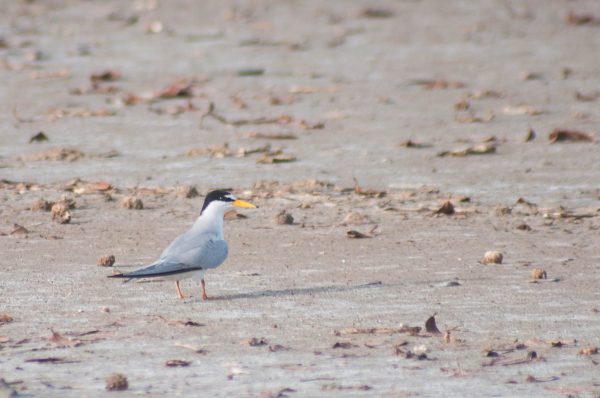
Get an inside look at science as it happens in the Caribbean. This week we investigate the nest of a lone pair of birds on St. Kitts.

Visiting the one of the salt ponds on the southern peninsula of St. Kitts, I happened upon a pair of Least Terns and their nest. In typical Least Tern style, their nest was basically just a pair of eggs on the ground. In this case, they were on a piece of garbage. Perhaps they thought it made the eggs less noticeable.
Some things about this nest were pretty normal. It was in the middle of the sandflat beside the pond. This is exactly the type of location Least Terns prefer for their nests: a bare, sandy area. It was also close to the shallow water of the pond and nearby shore where the terns could fish. The odd thing about this nest was that it was that it was alone.
Like many seabirds, Least Terns usually nest in colonies. Colonies may be as small as a few nests, or as large as several hundred. There are many potential advantages to nesting in a colony. For example, it would be hard for a small bird like the Least Tern to defend against a larger predator like a seagull. A group of Least Terns might be able to defend their chicks more easily.

Birds may also nest in colonies because they like a certain type of nest area. The Least Tern likes open sandy areas near water, but they also have to avoid sites where big waves would wash away their nests. If the number of great spots is limited, birds might be more likely to nest near each other.
So, why was this pair nesting all alone? There’s no easy answer. Least Terns are known to nest alone on occasion, but we don’t know why. Could it have been the first pair of a larger colony? Probably not. If it were, there would be other terns nearby, even if they hadn’t started their nests yet. Could it be the last pair from a colony that had already failed and moved on? It’s doubtful. If this happened, it’s unlikely that their nest would have survived.
Perhaps this lonely colony reflects the larger challenges facing Least Terns. Although the species is not near extinction, it does face many threats. Invasive predators—like monkeys, mongoose and rats—add to the dangers of native ones like herons and egrets. Suitable habitats are destroyed, and nests are crushed by off-road vehicles. Is the lonely colony the sign of a lonely future?
